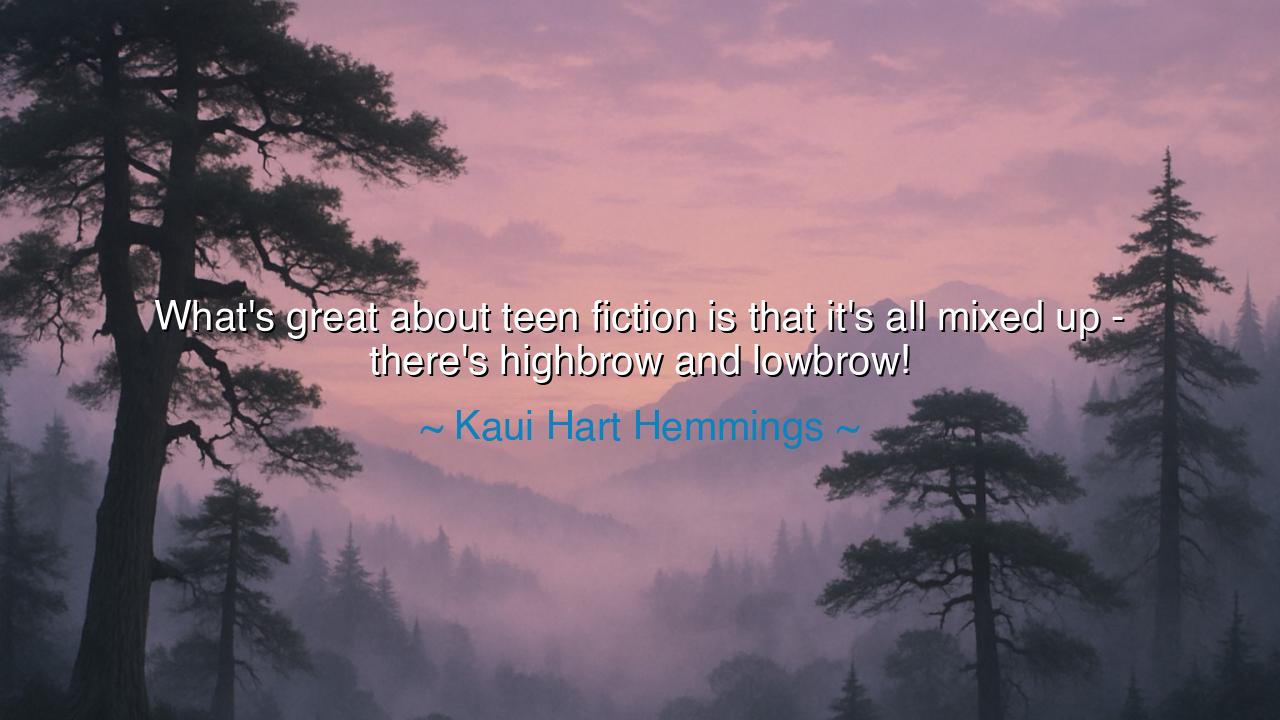
What's great about teen fiction is that it's all mixed up -
What's great about teen fiction is that it's all mixed up - there's highbrow and lowbrow!






Listen well, O children of wisdom, to the words of Kaui Hart Hemmings, who declared with delight: “What’s great about teen fiction is that it’s all mixed up—there’s highbrow and lowbrow!” At first glance these words may seem simple, spoken in passing about the nature of books for the young. Yet hidden within them lies a profound truth about art, about humanity, and about the strange and wondrous chaos of growing up. For in teen fiction, as in the lives of those it serves, the lofty and the humble, the profound and the playful, the wise and the foolish, are all mingled together, each giving meaning to the other.
Consider the nature of highbrow works: stories of deep philosophy, literary elegance, and intellectual ambition. These tales lift the mind upward, stretching it toward beauty and wisdom. Now set them beside the lowbrow—tales filled with humor, melodrama, fantasy, or wild imagination. These stories may not aspire to scholarship, but they bring laughter, comfort, and escape. And Hemmings reminds us that in the realm of teen fiction, these two are not enemies but companions. They mingle freely, as youth itself mingles idealism with recklessness, wisdom with folly, joy with despair.
Is this not the essence of the teen years? A boy or girl may one day ponder the meaning of the universe, and the next day obsess over a fleeting crush. They may weep over Shakespeare in the morning, and cheer for superheroes in the evening. Their lives, like the books they read, are “all mixed up,” and therein lies their beauty. For out of this confusion emerges identity, strength, and the first shaping of destiny.
Consider, for example, the tale of Mary Shelley. She was but eighteen when she began her novel Frankenstein, a work that soared with highbrow themes of creation, morality, and the limits of science. Yet it was also infused with the lurid, the lowbrow thrills of horror and grotesque imagination. In her mingling of both realms, she created a story that has endured for centuries, one that speaks to scholars and common readers alike. She showed that greatness is often born not of purity, but of mixture.
Thus Hemmings’ words echo across time: that teen fiction is a realm where the noble and the playful meet, and where no boundary need divide them. To dismiss the lowbrow is to deny the joy of laughter and fantasy; to scorn the highbrow is to abandon the search for truth and depth. Only when both are embraced can the soul of youth be truly nourished, for it craves not one or the other, but both together.
The lesson for us is clear: do not divide life too strictly between lofty and humble things. Do not despise the comic in favor of the tragic, nor reject the simple in pursuit of the profound. For wisdom lies in the weaving together of both. Just as teen fiction thrives in its mixture, so too does life flourish when the heart allows for both laughter and learning, for play and for seriousness, for the heights of philosophy and the simplicity of joy.
Therefore, let us act with balance. Read deeply, but also read widely. Cherish the poems of sages, but do not scorn the tales that bring delight to the weary soul. Let your own life hold both gravity and mirth, discipline and freedom, dreams and realities. For as Kaui Hart Hemmings has shown, the greatness of teen fiction—and of life itself—is not in keeping things divided, but in letting all things mingle, until from their mixture arises the fullness of the human spirit.






AAdministratorAdministrator
Welcome, honored guests. Please leave a comment, we will respond soon